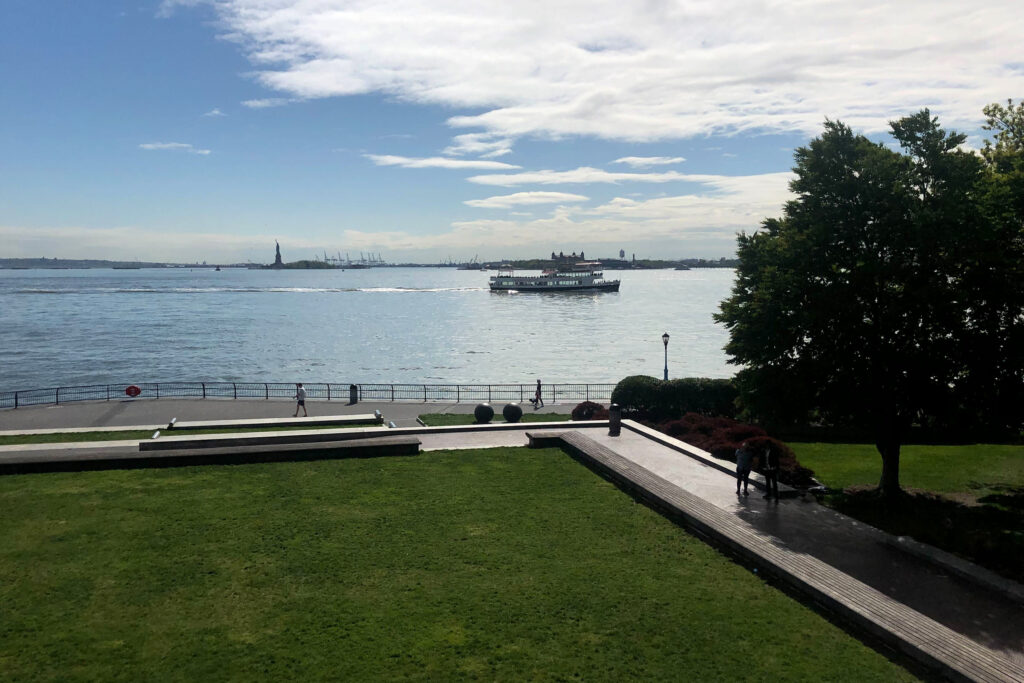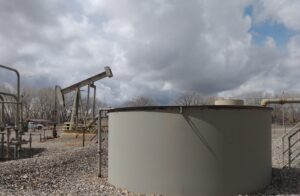In Battery Park City, Another Plan to Destroy a Green Space In Order to Save It
7 min read
A resiliency project in Lower Manhattan aims to provide flood protection in part by giving an iconic park a facelift — emphasis on lift.
The Battery Park City Authority’s plan to guard the neighborhood from flooding and future storm surges will take shape this summer, when Wagner Park closes to the public and a two-year construction period begins to raise the green space over 10 feet higher than it is now.
The work will also include a new pavilion overlooking the park and a continuous flood protection system — from the Museum of Jewish Heritage through Wagner Park and Pier A, snaking along the north edge of Battery Park to Bowling Green Plaza — with buried and exposed flood walls and flip-up gates that can be deployed for a storm.
While many neighbors and elected officials welcome the protection from looming climate change, concern over the popular park’s demolition is top of mind for some.
“Wagner Park is the absolute crown jewel of our neighborhood,” said John Dellaportas, a lawyer and vice president of The Battery Alliance, a local volunteer-run nonprofit.
“During Hurricane Sandy, it did not flood. It was on high ground,” he added. “The notion that you need to spend several hundred millions of dollars to tear up one of the most beautiful parks in all of New York City in order to reconstruct it strikes us as a bit of a scam.”
And while Tammy Meltzer, chair of Manhattan Community Board 1, which encompasses Wagner Park, acknowledged that “we need to do resiliency work,” she also feels “the timing, the scope and scale — that leaves me very uncomfortable.”
Officials from the city and Battery Park City Authority will present updates on Lower Manhattan’s coastal resiliency projects to CB 1 on Monday, May 16. A hearing on May 19 will offer the public the opportunity to provide feedback on the draft environmental impact statement for the project.
Taking the Lead
The $221 million plan, known as the South Battery Park City Resiliency Project, will be the second resiliency project to break ground in Manhattan, following the East Side Coastal Resiliency project last year — which faced fierce opposition in the lead-up to the project that will raze then raise the park.
Eventually, the south Battery Park City project will link with projects to the south and north as part of the overall Lower Manhattan Coastal Resiliency plan.
“We feel a great sense of urgency,” Battery Park City President and CEO B.J. Jones told THE CITY. “There’s an element that’s not just about flood protection and it’s not just about providing public space that will stand the test of time, but it’s also trying to lead by example, and so I hope that what we do here will be helpful in informing those other projects in Lower Manhattan and beyond.”
The resiliency project has been years in the making, designed in the wake of Hurricane Sandy to protect Battery Park City from storm surges and sea-level rise. Construction is set to begin in August and is expected to be done in March 2025.
Wagner Park, a 3.5-acre space designed by landscape architecture firm OLIN, boasts a waterfront lawn and views of the New York Harbor. The park will close for two years during construction, and it will be elevated, to a total height of 19.8 feet. A flood wall will be buried beneath the ground at the park.
Doing construction in phases and allowing part of the park to remain open would take longer, be technically more difficult and jeopardize safety, according to the Battery Park City Authority team.
“It’s a wonderful park with a beautiful pavilion,” said Alice Blank, vice-chairperson of CB1, of the current space. “There were questions then which remain today as to why this relatively high ground in Lower Manhattan needed to be made resilient, in light of the fact that the Battery and Hudson River Park are not undergoing this approach.”
Whereas the Battery and Hudson River Park are expected to accommodate some flooding, the idea is to keep Wagner Park as dry as possible and use it to protect the buildings behind it.
The design team contemplated moving the flood barrier line further inland to allow the Wagner Park to flood during storms, but ultimately decided against it.
“We wanted to make sure that the park itself was accessible and remained accessible for the use of the community,” said Gwen Dawson, Battery Park City Authority’s vice president of real property. “With more and more frequent storms occurring, the projections were pretty dire and suggested that there would be significant periods of time and extended periods of time that the park would become unusable and inaccessible to the public if it was not also part of the area protected.”
During future storms, water could rise to anywhere between 18 to 23.5 feet high, as lamp posts painted blue along the esplanade indicate.
The current brick pavilion, designed by architecture firm Machado Silvetti, will be replaced with a new, three-level structure featuring a restaurant, community room and education center with programming by the Parks Department, public restrooms and a publicly accessible rooftop.
East Side Connection
Concerns around the South Battery Park City Resiliency Project echo some of those regarding the East Side Coastal Resiliency project on the Lower East Side.
A main component of the plan involves razing East River Park and elevating it, with a flood wall installed beneath, for storm surge protection. Some locals have protested at the site and filed lawsuits to stop the construction, decrying the park’s destruction.
Part of the strife was due to a sudden shift of plans: the de Blasio administration had for years worked closely with the community to come up with an initial plan — different than what’s happening now — but changed it without consulting the neighborhood.
Councilmember Christopher Marte has been one of the vocal opponents of the East Side Coastal Resiliency Project, which lies just beyond the border of his district. He backs an alternative “community plan” for the east side instead.
But he said he’s “fully supportive” of the Battery Park City Resiliency Project, which is in his jurisdiction.
“It’s been a long time coming and we can’t wait any longer. I know it is not a perfect plan, but I think it’s a good enough plan to protect us, especially from storm surges,” he said.
What’s different for Marte? He said the Battery Park City Authority communicated well, kept the community board informed and answered questions to provide transparency.
Indeed, the Battery Park City Authority specifically wanted to avoid such a backlash and sought to engage the community, the team said. Documents show the authority briefed community residents on the plan since at least 2016 and altered parts of the designs based on feedback.
Still, there’s frustration from several Battery Park City residents that not all feedback was taken into account. Plus, not all neighbors feel like they were in the loop or meaningfully involved in the project’s planning — and they want another look at the plan.
“We just find out that they’re closing the park one day, and here’s the plan,” said Daniel Akkerman, president of The Battery Alliance, who said he would’ve wanted the Authority to directly reach out to representatives and boards of residential buildings. “We recognize there’s a need for resiliency. We just want community input.”
Several Battery Park locals lamented the destruction of the current pavilion and temporary but extended loss of precious green space — similar to how some Lower East Siders feel about East River Park.
But that’s a reality New Yorkers may increasingly have to face in planning for a resilient future, said Amy Chester, managing director of Rebuild By Design, a federal effort launched by the U.S. Department of Housing and Urban Development after Sandy.
“We are going to have to, unfortunately, change the way we live and that’s going to include destroying things to recreate them and in a better, environmentally sensible way,” Chester said. “Or else otherwise, we’re going to be rebuilding from storms, and that’s after we suffer.”
Any delays in implementing the project could leave people, infrastructure and investments of Lower Manhattan vulnerable for longer.
To the north up to Tribeca, Battery Park City Authority is expected to break ground on its North and West Resiliency Project in September 2023. That project, estimated to cost $630 million and be completed in February 2026, features a continuous flood barrier from 1st Place to North Moore Street. This will connect with the South project in a way that is “to be determined,” Dawson said.
When the two projects are linked, they’ll offer protection for the 100-year storm in 2050, which means a storm that has a 1% chance of happening will occur more frequently and with greater intensity.
“As we approach the 10-year anniversary of Superstorm Sandy, clearly, we’re beyond the short-term timeframe and moving into the long term,” said Catherine McVay Hughes, a member of the Battery Park City Authority and a former chair of CB1. “Shovels in the ground are really important, particularly after extended community engagement.”
This article was originally posted on In Battery Park City, Another Plan to Destroy a Green Space In Order to Save It






